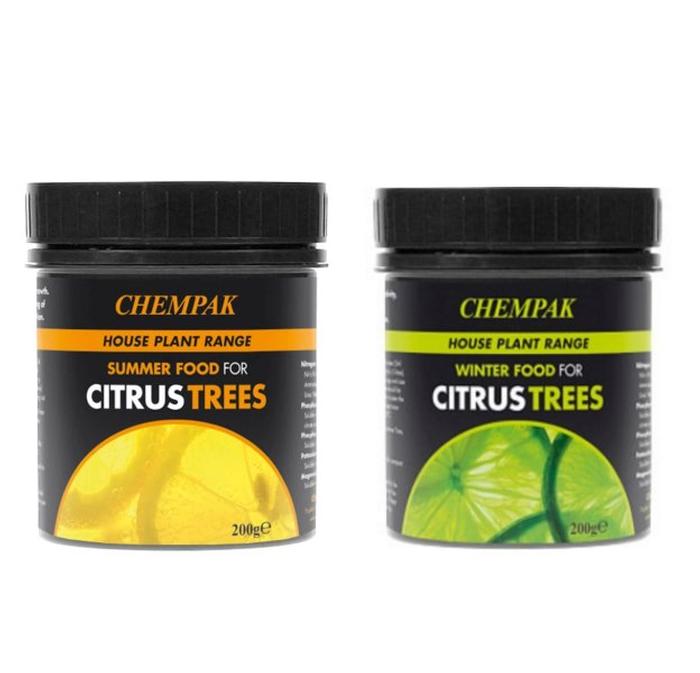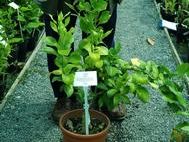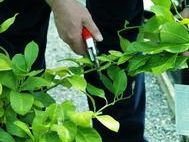- Shop Now
- Burncoose Specialities
- This Month
- Offers & Promotions
- RHS Chelsea Flower Show 2024
- 40 years at Burncoose
- Engage With Us
- Information, Help & Advice
- About Us & Our Services
- Terms & Conditions
- Log In / Register
Chapters
Citrus Trees - Care Guide
Feeding, Planting & Pruning
Light: Citrus plants can cope with our outdoor and glasshouse light levels but should be given a high level of light indoors (either through windows or artificial lighting) being careful not to allow leaf burn in direct summer sun through glass.
When there is no danger of frost, citrus plants like to be outside through the summer months. However, they must be acclimatised gradually to the new light level, by being moved first to a slightly shaded area outside for 2-3 weeks before being put in their sheltered, sunny spot for the summer. Equally, when being brought indoors in winter, they should be kept in the shade for 2-3 weeks before coming inside. This reduces any stress to the leaves that the sudden light change could cause.
Small plants should not be put outside in their first season.
Heat: Citrus trees can tolerate temperatures down to 4°C (even 2°C for short periods) but they must not be frosted. They are also tolerant of high temperatures but prefer to be at neither extreme for too long. Owners are often unaware of just how hot their greenhouse can become on sunny days and of the stress it can cause.
 Feeding: During the growing months, the plants should be fed every 2 weeks with a tomato-type fertiliser and given the occasional dose of sequestrated iron (and if possible trace elements) if any yellowing of the leaves occurs. We have a Citrus Feed - summer and winter formula available in our sundries section of the website.
Feeding: During the growing months, the plants should be fed every 2 weeks with a tomato-type fertiliser and given the occasional dose of sequestrated iron (and if possible trace elements) if any yellowing of the leaves occurs. We have a Citrus Feed - summer and winter formula available in our sundries section of the website.
Pests: The most likely pests are woolly aphis and red spider mite. These can be easily controlled with an appropriate off-the-shelf spray. Occasionally scale insect may settle on citrus, and can, again, be easily killed with an appropriate insecticide spray, or by dabbing with methylated spirit.
Water: Water sparingly in winter without letting the pot dry out completely and increase the amount of water once growth starts in the spring. In a hot greenhouse or conservatory the plants will dry out more quickly and may need watering as often as once a day in sunny weather.
Humidity: In hot weather and in central heating, humidity can drop dramatically. If the leaves show signs of stress, the humidity can be raised by a fine spray or standing pots on a tray of wet gravel. Increased humidity will also discourage any red spider mite attack.
Flowers and Fruit: Generally flowering takes place in May but may occur several times in the year in more mature plants. A number of fragrant flowers appear but only about 1% will set (more than this would overload the branches when the fruit reaches full size).
The fruit gradually develops and turns colour around Christmas time. (The colder weather tends to act as a trigger for colouring.) It will then stay on the plants for several months after ripening.
Leaves: Citrus trees are evergreen and will naturally drop an old leaf from time to time. If, however, there is a lot of leaf drop, then the first thing to look at is whether the plant is too dry. This is generally the cause. The second most common reason is poor light, so moving the tree to a lighter position may solve the problem.
Should the leaves drop for any reason, do not be immediately discouraged, as the plant will most likely grow a new crop of beautiful glossy leaves in a month or two, and flower soon after.
Compost: Citrus trees need a slightly acid environment. The pH should be between 6 and 6.5, (Lemons slightly lower pH than Oranges) so use ericaceous compost. Do not use composts containing lime as they will have a higher pH. Most multi-purpose composts also contain lime and have a fairly high pH so should be avoided. Keep the compost open by using an additive mixture such as horticultural grit, sand and grit mixture, or coarse grit. This will improve the drainage and prevent over watering. Do not be tempted to use left over builders sand as this may contain lime.
Pruning: Citrus trees can be pruned to the desired shape and size at any time, however it would be better to prune your tree immediately after fruiting and before the new growth starts to appear. This would then encourage the tree to produce new branches within the area and size you require instead of extending its width and height. With a continuously fruiting variety this may mean sacrificing any blossom or fruit that may be on the tree at the time. January or February would be the preferred time.
There are no special instructions, but the tree will produce a branch from each leaf node so take this into account when cutting back in order to produce a good shape. Cut back to a leaf node that is pointing in the direction you would like to see the new growth take, i.e. pointing upwards and not down, although it is natural for new growth to seek out the light and to grow up rather than down. You do not need to be too particular.
















